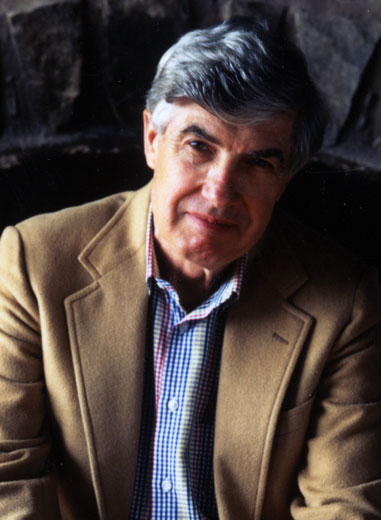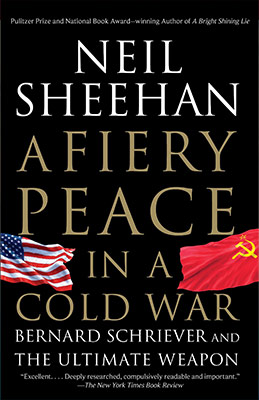A Fiery Peace in a Cold War: Bernard Schriever and the Ultimate Weapon
In this never-before-told story, Neil Sheehan – winner of the Pulitzer Prize and the National Book Award – details American Air Force officer Bernard Schriever’s quest to prevent the Soviet Union from acquiring nuclear superiority, and describes American efforts to develop the unstoppable nuclear-weapon delivery system, the intercontinental ballistic missile, the first weapons meant to deter an atomic holocaust rather than to be fired in anger.
In a sweeping narrative, Sheehan brings to life a huge cast of some of the most intriguing characters of the cold war, including the brilliant physicist John Von Neumann, and the hawkish Air Force general, Curtis LeMay.

About the Author
Neil Sheehan
Neil Sheehan is the author of A Bright Shining Lie, which won the National Book Award in 1988 and the Pulitzer Prize for nonfiction in 1989. He spent three years in Vietnam as a war correspondent for United Press International and The New York Times and won numerous awards for his reporting. In 1971 he obtained the Pentagon Papers, which brought The New York Times the Pulitzer Prize Gold Medal for meritorious public service. He died in 2021.
Book Club Session
Session Notes:
Air Force Historical Foundation Book Club
A Fiery Peace in a Cold War: Bernard Schriever and the Ultimate Weapon
by Neil Sheehan
Moderated by Mr. John “Pepe” Soto with Gen Mike “Mobile” Holmes, USAF (Ret) and Maj Gen Thomas “Tav” Taverney, USAF (Ret)
28 June 2022
28 Groups in Attendance
Key Take-Aways:
- Gen Schriever had the courage of his convictions. He was not obnoxious about it but believed passionately in what he thought was right and that’s tough to do. If you think it’s the right thing to do, don’t be afraid to carry the message.
- We currently have a problem with the acquisition process matching the urgency of our national security requirements. Schriever was able to circumvent bureaucracy through non-standard rules and making the system work for his priorities.
- We are going into Cold War 2.0 at the same state of starting with a perception of being behind the power curve in development in reference to hypersonics, for example, compared to Russian and Chinese combat tested and prototyped munitions. The question is not a matter of being to observe threat capabilities demonstration, rather to react in new and flexible ways.
Opening Remarks by Mr. John “Pepe” Soto, Gen Mike “Mobile” Holmes, USAF (Ret) and Maj Gen Thomas “Tav” Taverney, USAF (Ret)
Pepe: This book is a great story about the Air Force and about Gen Bernard Schriever who was one of the forefront thinkers of the Space enterprise.
Tav: There were two elements to succeeding in the Space Race achieved by Gen Bernard Schriever. One element was getting the program going and achieving non-standard rules to make it a national priority. Schriever was able to leverage key individuals with technical clout (Von Neumann) and political clout (Eg. Gardner “The Wild Welshman”) to achieve his objectives.
Secondly, the Gillette procedures established by the Gillette committee offered Schriever the opportunity to cut through bureaucratic routing to get direct access to the President and other national decision makers.
No one else other than Schriever could have achieved this as he was a perfect combination as a member of the greatest generation, a WWII vet, and had Hap Arnold as a mentor.
General Arnold, and subsequently, Gen Schriever pushed the importance of technology in the Air Force and did it with the courage and commitment of doing the right thing. An example of Schriever’s commitment was when he was merely a one-star General in a room full of Generals at Camp Cook and told people that their common approach was wrong. He particularly took on Gen Curtis LeMay’s bomber force to which retired LeMay later told him that he would not have promoted him to his final rank of four-star General.
Schriever did many things right, to include choosing the right people and empowering them. He was not obsessed with retaining power and control. He looked to contractors for technical advice, while allowing Air Force people to make decisions. He made decisions based on a schedule, invented systems engineering, and did concurrency well, pushing tech across all areas of his organization simultaneously. He built and developed the ATLAS and TITAN systems simultaneously to encourage competition, each system having its own set of rules, but retained the same management construct.
Mobile: This book offers a perspective of how to introduce something new in the military. The Colonels and Generals at the start of the war, were the 4-Stars at the end of the war when the US beat Germany and Japan. These individuals could only envision doing the same things they did during the war when they became their own service. Conversely, Schriever was a lieutenant at the beginning of the war who became a Colonel by the end of war. The younger guys fought just as hard during WWII, were valorous and were not as attached to doing things the way they did them during war. They returned from the war, got degrees in systems engineering and imagined a better way to roll out nukes.
Three significant milestones in a new military (Air Force) way of thought and personnel associated with them include the advent of Air Power (Billy Mitchell), nuclear deterrence and the Intercontinental Ballistic Missile (Bernard Schriever) and the success of interconnected advanced platforms with precision weapons and stealth capabilities in the end of Desert Storm (Warden, Horner, Deptula).
What does it take for a new way of thought?
-
- A new idea
- Idea to be wrapped around a person
- Direct access to people in government
- Face strong peer competitor recognized by country as a threat
This book has two great stories of how we got a shift to Nuclear ICBMs (from the bomber force) and an illustration of what it takes to drive change. My (Gen Holmes’) generation was modeled on Desert Storm and the power of precision weapons and command and control by the Air and Space Operations Center (AOC). The current generation is modeled on counterterrorism and violent extremists in which the AOC was replaced by a strike cell construct and decisions were often made by the Ground force commander. We need to examine what it takes now to win a war against a competitor.
Q&A:
- The book uses the life of Bennie Schriever as the focal point of telling the story of the Cold War and the Soviet and American arms race. Given today’s version of the Cold War (2.0), what are key lessons we can learn from what our Air Force did in the first Cold War?
Tav: We are currently where we were when Gen Schriever came on board. After WWII we had spent so much money and we didn’t have enough money to do what we wanted to do. In October 1957, the USSR successfully launched Sputnik and demonstrated being ahead on the Space program. Today, Russia and China are demonstrating hypersonics and scary space capabilities. In our program development, we start with the perception of being behind.
Mobile: We need to have an acquisition process built for speed. We are currently concerned with oversight and contract job security.
It appears we’re in an arm’s race on Hypersonics right now. What lessons from the book can we use to win this race?
Tav: The issue with hypersonics is they fly below 60k ft and hide and maneuver in clutter which is a challenging problem. Congress is frustrated with the speed at which the Department of Defense operates, which is not the fault of programs, rather the fault of the rules. A Program of Record requires months to make a change. The current Air (Space) Force system is not set up to make changes like with Schriever. The tools aren’t there other than with programs like the Rapid Capabilities Office (RCO), AFWERX and the Space Development Agency (SDA).
Mobile: In fiscal competition between the development of hypersonics versus looking to replace legacy systems to include national platforms, various factors come into play between districting and who gets money for what program.
It appears in the book that our misconception of the Soviet Union’s intentions drove a lot of our strategy. One could argue that this is a constant issue for us. Why do we seem to get the Soviet/Russians wrong? How do we get a better gauge of the threat from the geo/mil standpoint?
Tav: With the infrastructure of NRO and Commercial Satellites the ability to hide tech advances is gone. For example, we were able to observe China’s suborbital hypersonic demo based on the surveillance capabilities available. Now the question is “how do we react in new and flexible ways?”
Mobile: Again, our Acquisition system is archaic. We can see threats, but do we have infrastructure to handle this in the US? We haven’t solved this problem. We think we have a good understanding of the J20 and the PL-15, yet we drug our feet on trying to develop something to give an Aircraft Commander the opportunity to counter these threats effectively. Controlling air and space is key to providing defense to island nations.
- Schriever appears to me to be right up there with Jimmy Doolittle as one of the great Airmen in the history of the Air Force.
Engineer
Scientist
Technologist
Tactician
Test Pilot
Acquisition Master
Master Team Builder
Visionary
It begs the question – why isn’t he more celebrated by the Air Force? Why isn’t he studied more? People know who he is, but not all he’s done…
Tav: If Schriever had stayed in the Air business, he would have made a significant impact there too. Significantly, he was the first living person to have an Air Force base named after him.
Mobile: Highlighting Air and Space power leaders to showcase to Airmen is part of the job in the Air Force Historical Foundation!
- One of my takeaways from the book is that Schriever, in building the industrial capacity to develop the ICBM, also built the foundation for the current military-industrial complex…do you think the process he developed is still doable today?
Tav: We can always depend on industry to do what it takes to make money. Contracts don’t incentivize schedule and speed if the government doesn’t change purchasing rules. Companies are ultimately in it to make money for their shareholders. The purchasing infrastructure is the problem.
Mobile: For solutions to American problems, someone has to make money. That’s the way our markets and systems are set up and it brings capabilities that no one else can have. A few examples include linked AI-driven companion combat aircraft, F-22s, F-35s. We can find a model that allows companies to thrive, [while benefiting national defense].
- Schriever seemed to have to deal with some very tough personalities in his career (as in his run-ins with Curtis Lemay). What do you think gave him the gumption to hold his ground/do the right thing in these types of conflicts?
Tav: He had really great mentors [to include]:
- His Mother was a strong woman who lost her husband and put Bennie in an orphanage while she worked multiple jobs to make ends meet.
- Hap Arnold, who was a role model with a vision for the future and supported Billy Mitchell.
- Others included Ennis Whitehead, George Kenney [who was one of greatest Airmen who ever lived], and his Father-in-Law, George Brett.
Mobile: In every career in the Air Force, there comes a point when you’re up against a decision to guess if your job is to do what your boss wants or to do what is right for his [or her] Airmen.
For example, as a Colonel, I was sure the 18th Ops Group in Kadena was mine, but I got sent to the Columbus AFB Flying Training Group and decided that this was my last assignment, which was a powerful thing. For some reason the Air Force kept giving me one more last job. For guys like Bennie, he did this as an 18-year-old.
- I found Theodore Von Karman to be one of the more interesting personalities in the book. I never heard of his paper, “Science: The Key to Air Supremacy” until I read this book. The key quote from that paper that’s highlighted in the book really got me thinking; “The men in charge of future Air Forces should always remember that problems never have final or universal solutions…and only a constant inquisitive attitude towards science and a swift adaptation to new developments can maintain the security of this nation through world air supremacy”.
- Does that quote still hold true today?
- Why is this paper not required reading for Air Force officers? I asked 10 retired officers (all WIC grads, and O6’s) and 10 active-duty officers (O8 – O5) and only ONE of them had heard of this paper – and he was a SAAS grad.
Tav: We’re always chasing the next threat. Gen Holmes talked about needing to have systems available to the changing threat. We need more processing power on spacecraft and to build systems faster with rapid launch and insertion into orbit capabilities. Like a pilot, turning inside of a dogfight, we need to turn inside of the Chinese/Russian decision-making cycle. We need to be more agile.
Mobile: We need to build environments to support this kind of innovation. There’s a great Hudson Institute paper that introduces this concept. Program offices need tech advisors. Companies could work for a program office to build platforms and sensors that are complex and plug into a system.
- What do you think Gen. Schriever would think, about the establishment of a separate Space Force?
- And what lessons can we take away from the fights Schriever took on between the “flying” Air Force and his missile force?
Tav: I think he’d be excited. He’s the father of all things Space in the DoD and the father of the Space Force. General Schriever received Tab #1 from Space Command.
Mobile: Hear Hear. It’s a large task that Gen Raymond and Space Force leaders have today. Imagine if Hap Arnold had to build the service at the same time as the capability as our Guardians are doing.
- All came home from war and went to get new degrees- how do we change our current Air Force to mimic this? Should folks get Master’s degrees that wicker the mission for success?
Tav: Following WWI, many veterans got tech degrees and had the GI bill which allowed the US to grow a whole generation. Now, only 20% of US college grads have STEM degrees whereas Russia, China and India all have 60% or higher graduates with STEM degrees. War had a lot to do with turning US manufacturing might into technical and innovation advantage.
Mobile: I received an electrical engineering degree over 6 years and found it helpful to explain weapons in my line of work. There are various explanations that people point to include the Air Force studies program highlighting that part of the problem in the AF is not having enough Senior leaders with tech degrees; others point to a bad acquisitions process and others focus on the loss of Air Force Systems Command which was threat focused and a good consolidation of different types of personnel to include from the ops, tech and science side of the house.
- (Participant Michael Binder) If not for Ed Hall, would Bennie Schriever be considered as successful as he is?
Tav: The Minuteman was the program we needed. Ed Hall’s assistance in the Thor and Titan engine likely contributed to the reason we developed things so fast, but that wasn’t the only element to success. Ed Hall’s name is in every Space Hall of Fame and he’s a phenomenally significant person.
Mobile: There’s a benefit of deep diving into the ICBM enterprise for example, the miniaturization of the warhead, liquid versus solid propellant and the command system of the enterprise. There were key contributors to each area, but there were so many areas.
- (Participant Rock Mendenhall) For Tav: what are your thoughts on deterrence in a new multi-polar world particularly in the context of Stalin’s history? Do we have any lessons learned that we can apply now to be more objective?
Tav: We are in a data rich information environment now. The question is “how can we get the data fused/assessed automatically?” How do we exploit the data collected? We need to make information into intelligence.
Mobile: 21st century deterrence will be something different with components in cyber and various other fields. The Administration’s White paper focuses on Integrated Deterrence and how to work to use all of the tools available to the Nation.
- (Participant Larry Benson) I did a book review of the book 12 years ago and always thought that one thing it doesn’t cover is how Schriever’s 7 years in AF systems command coincided with the time of McNamara. I hope that a young AF officer will do a paper on these observations and take aways.
Tav: I had the fortune of being at Gen Schriever’s 90th birthday party and he referenced McNamara. This would be a good paper study.

